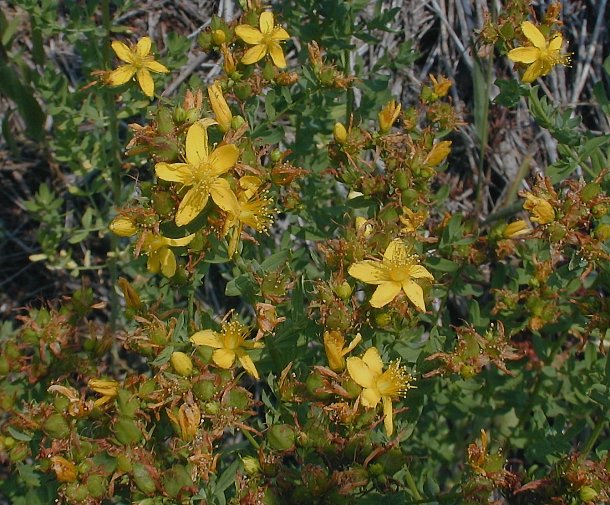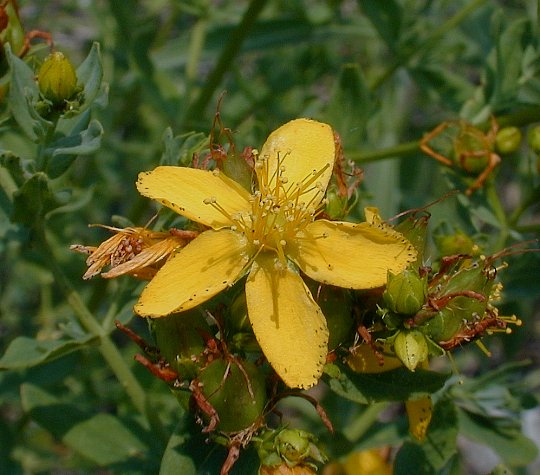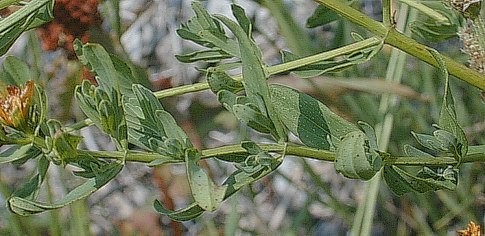Description: This herbaceous perennial plant is 1–2½' tall, branching frequently. The round stems are hairless and light green; the larger stems have a pair of small longitudinal ridges. The opposite leaves are about 1" long and 1/3" (8 mm.) across. They are oblong, hairless, and sessile. The surface of these leaves is perforated by numerous translucid dots, and there are often scattered black dots along the margin of the lower surface. The upper stems terminate in flat-headed clusters of several flowers (cymes). Each flower is about ¾" across, consisting of 5 yellow petals, 5 green sepals, 3 styles, and numerous stamens (more than 20). There are scattered black dots along the margins of the petals. The sepals are lanceolate and much smaller than the petals.

The blooming
period occurs from early to mid-summer and lasts about a month. The
petals turn brown and persist near the seed capsules, rather than
falling to the ground. Each 3-celled seed capsule is well-rounded at
the base, becoming conical at its apex. Each cell of the seed capsule
contain numerous seeds, which are oblong, flattened, and black. The
surface of each seed is somewhat roughened by numerous small pits,
rather than smooth. The root system is rhizomatous, and produces
numerous basal offshoots around the base of the plant.
Cultivation:
The preference is full sun and mesic to dry conditions. Common St.
John's Wort adapts to virtually any kind of soil that contains loam,
sand, or gravel; there is a preference for soil that is alkaline. This
plant can spread aggressively by forming vegetative colonies, and can
be difficult to get rid off.

Range &
Habitat:
This is a common plant that occurs throughout Illinois; it is
especially common in the northern and western areas of the state (see Distribution
Map). Habitats include mesic to dry sand prairies, barren
savannas, degraded weedy meadows, gravelly areas along railroads and
roadsides, pastures and abandoned fields, and sterile waste areas.
There is a preference for disturbed areas with little vegetation.
Common St. John's Wort was introduced into North America from Europe as
a garden plant.
Faunal Associations:
Bumblebees and other kinds of bees visit the flowers to collect pollen.
Occasionally, Syrphid flies and beetles may feed on the pollen,
although they are less effective at pollination. The showy flowers may
attract other kinds of insects (e.g., wasps and butterflies), but they
are vainly seeking nectar, which the flowers don't produce. The
caterpillars of the butterfly Strymon melinus (Gray
Hairstreak) feed on the seed capsules of Hypericum spp.
(St. John's Worts), while the caterpillars of the moth Nedra
ramosula (Gray Half-Spot) feed on the foliage. Mammalian
herbivores are not attracted to Common St. John's Wort as a food plant
because it can cause a photosensitive reaction (particularly in
light-skinned animals) and gastrointestinal distress.

Photographic
Location:
An area with limestone gravel along a railroad in Savoy, Illinois.
Comments:
This species is usually in bloom during the summer solstice (dedicated
to St. John), hence the common name. Common St. John's Wort is unique
among the Hypericum spp. (St. John Worts) in
Illinois because it has black dots along the margins of its flower
petals. The species Hypericum punctatum (Dotted St.
John's Wort) has black dots and streaks along the interior of its
flower petals, while other St. John's Worts have petals without any
black dots. Common St. John's Wort branches more than Dotted St. John's
Wort, and it has larger flowers (about ¾" across) than the latter
(about ½" across). The seeds of Common St. John's Wort have a surface
that is somewhat roughened by small pits, while the seeds of many
native St. John's Worts have a smooth surface.